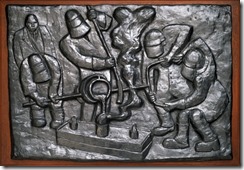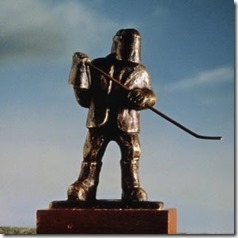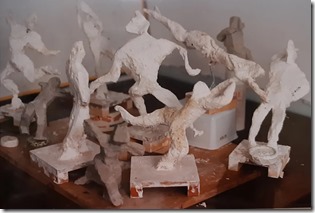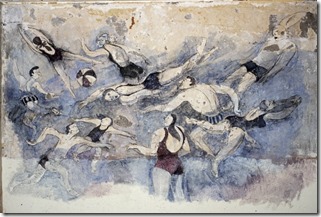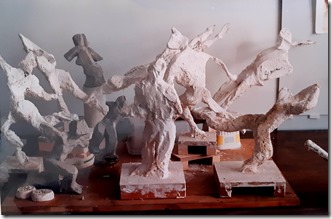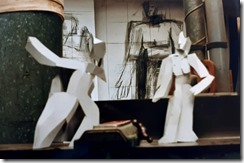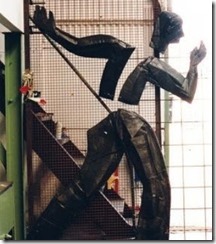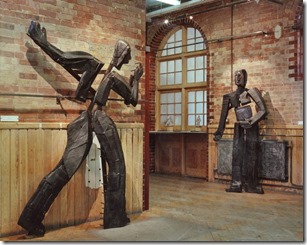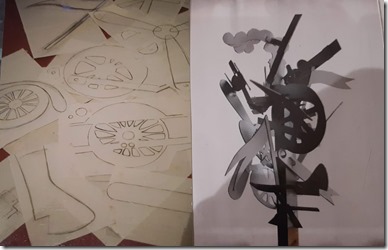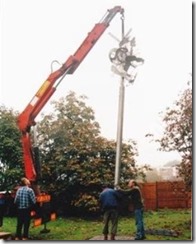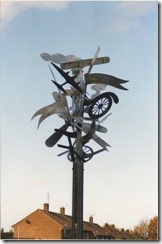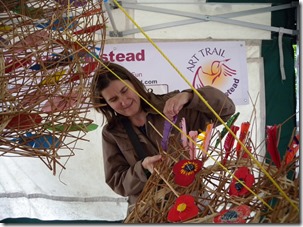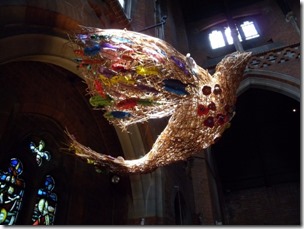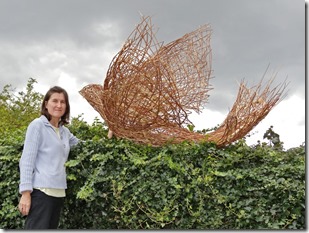September 2023
My Foundry Story by Anna Bisset.
1/10 “Foundrymen” cast iron 1991. Not long out of college, as a struggling artist, I took up an admin post in the family business, an engineering Foundry, where I had access to facilities for making castings using the sand mould method. This piece was one of the first 3D pieces I made, having been primarily a painter up to this point. It won the “Youth Prize for Sculpture” in an art competition in Herts and I met Patricia Gibberd, one of the judges, wife of Frederick Gibberd, who designed Harlow New Town, which he then filled with lots of amazing modern sculpture you can still see today. This was the start of My Foundry Story.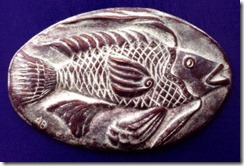
2/10 “Fish plaque”, bronze, 1989. On the Enterprise Allowance Scheme in the late 1980’s, I was getting some work as a scenic painter and one of the photographers I worked for, Julie Fisher, heard about my links with the Foundry and asked me to make a door-plate for her studio in Hoxton. This was the result, made of cast bronze – I also learnt how to create the copper oxide finish with various chemicals in my Foundry Studio, a highly toxic process. From this point, I started to make name and numberplates for houses, leading to a few larger commissions. All the original patterns were modelled in clay.
3/10: “Grace Darling”, cast iron, 1990. The low-relief castings I was making were getting bigger. The sort of sand I was using was so fine it would show your fingerprints in the clay modelling. This commission depicted the heroine of Longstone Lighthouse, who, in 1838, aged 23, accompanied her father one stormy night to save ship-wrecked sailors of the Ss Forfarshire on Big Harcar Rock. They saved 9 survivors of the wreck and both were awarded honours for their bravery. This cast iron piece is in a private collection in St Lucia, Caribbean. By this point, I was used to designing on paper and then translating the image into low relief, but fully 3D would come later.

4/10: Family Influences. It’s not often that you think about how your work comes about, but looking back you can sometimes see it – in her job as an occupational therapist my mum made things in plaster, clay and other materials. Here are a pair of pelicans – modelled in clay and cast in plaster. They had been sitting on the shelf in the lounge for years before I found out in my thirties that my mum had made them. Likewise with the deer, which would have been modelled in clay but cast in iron and then nickel-plated to give the shiny finish – no doubt my dad’s idea – It’s imprinted “ERM” – Enfield Rolling Mills, 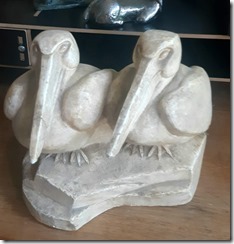
 down the road from Enfield Foundry. My dad was an ideas man. One of his ideas for me when I left college was that he’d like a small foundryman made as an award for long-serving employees – forget the gold watch – as a 3D piece, it would have to be lost wax and he came up with the very place to have this cast. More in my next post.
down the road from Enfield Foundry. My dad was an ideas man. One of his ideas for me when I left college was that he’d like a small foundryman made as an award for long-serving employees – forget the gold watch – as a 3D piece, it would have to be lost wax and he came up with the very place to have this cast. More in my next post.
5/10: “Foundryman”, bronze, 1987. Because of the fine detail and the undercuts, a 3D figure like this one would need the “lost wax” process for casting in metal. My dad said to get in touch with the Royal College and to ask for Tissa Ranasinghe who ran the bronze foundry. Tissa took on the job of producing 3 copies of the Foundryman, plus he showed me how he made the “skimmer” that the figure was holding from a separate piece of bronze wire. The photos show 2 different finishes, the greenish copper oxide and the brown iron oxide finish. I was surprised at how much interest he took in working on the Foundryman. I have since discovered that Tissa, as well as being an expert in bronze casting, was also a noted sculptor, achieving many awards in his lifetime in his native Sri Lanka and around the world, before moving to London to work at the RCA. Born in 1925, he died in 2019.
6/10: Bathers Mural morphs into sculpture. On my MA course at UEL, tutor Stan Steele asked: “If you were going to be really ambitious, what sort of sculpture would you make, no holds barred”. I said, “I’ve done this Bathers mural and I’d like to make it into a group of 3D sculptures for the pool in front of Walthamstow Town Hall (this was 1994, when there was a pool with cars going round it). “OK”, he said, “First, make your maquettes, worry about the rest later”. So I did.
7/10: Figurehead for Docklands 1995. Hard to explain how much this piece of work means to me. Taking one of the figures from the Bathers images, I developed it into a piece in a UEL exhibition, Tidal Basin II, when it was shown on an upturned skip. Apart from the framework, I welded it all myself – still holding together as far as I know. After some follow-up, it was then purchased by LDDC and installed permanently in 1998. Still there in Poplar Dock, not far from where my Granny was born in Burdett Road. More photos and info on my website – see the bio. 
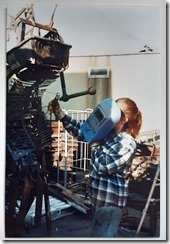
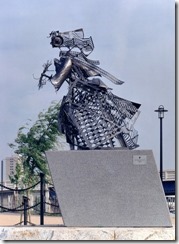

8/10: “Cast Iron Men”, cast iron and welded steel, 1996. These pieces were made of individual castings bolted together onto a welded steel framework, custom-made for each sculpture. Whilst I designed the work and saw it all through, it was the men in the foundry, starting with my brother, David Bisset, MD at the time, Don Kingerley and Bill Kirby, foundry managers, Tony Shaw in the pattern-shop, Dave Edwards and John Sippings in the machine-shop, and Chris Sippings, welder, and others who worked with me on the sculptures, tolerated my requests and supported me throughout the process, so this one is for them.
9/10: “Propeller Post”, stainless steel, 1999. – Site-specific for the Alban Way, in Hatfield, part of the Sustrans Cycle Network, my first large-scale commission after the MA at UEL. Bicycles, cars, aeroplanes, trains, creating a vortex of images from Hatfield’s illustrious past in transport, including de Havilland’s Mosquito and the Comet. The most planned of the three large pieces, this was won with a scale model, pic 2. The stainless-steel pieces were cut out with a gas-cutter, fettled and brushed then assembled onto a square section pipe and welded into place, one by one, following the scale model. Possibly my most complex piece, as each stage had to be planned to fit with next, finishing with installation to the correct depth for the weight and height of the sculpture. We needed a quantity surveyor for this. I was happy with the result – a piece that co-ordinated the work of many different people into one finished sculpture, which is exciting!
10/10: What next? Sadly, the sculptural work was put on hold when the Foundry relocated out of London and I moved into teaching. While I have mainly worked in 2D since then, painting, drawing and printmaking, I am always on the lookout for the chance to work in 3D. Here is one such piece of work: “Peace Dove for Wanstead”, commissioned to help commemorate the Centenary of WWI in 2014. Taking advice from a friend who knows the material, I made it in willow. It was easy to construct in my studio at home, and I was able to move it around from place to place for different events. I took it to a local festival and to a local school for workshops; it appeared in a pub, a church, a college and a community centre and it ended up in St Barnabus Church, Walthamstow for the E17 Art Trail 2014, hanging over the font! It is still there as far as I know!

